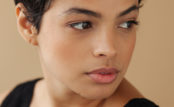 Is it asking too much to have a healthy mane with free-flowing, plentiful hair? Apparently nature thought fit to throw another challenge in the works with dandruff – those white flakes that linger in your hair, on your clothes, and more often than not, make you feel just a little embarrassed.
Is it asking too much to have a healthy mane with free-flowing, plentiful hair? Apparently nature thought fit to throw another challenge in the works with dandruff – those white flakes that linger in your hair, on your clothes, and more often than not, make you feel just a little embarrassed.
Roughly half the population gets dandruff. On a scale of 0 to 80, with the former being mild and the latter the most problematic flaking you can imagine, most folks fall between 15 and 30. Dandruff is visible to the naked eye at 15.
You can get rid of dandruff a variety of ways, from relatively mild over the counter shampoos to prescription treatment for more persistent cases. And for people who’d prefer to treat dandruff with a more natural touch – without the sometimes harsh chemicals in dandruff shampoos – there are more than a few home remedies for dandruff lying in your kitchen or bathroom.
But first, let’s look closer at why you get dandruff, and the various treatments at your disposal.
About Dandruff
Dandruff’s not about your hair. It’s about your scalp, actually, and skin cells that exfoliate every four to seven days rather than the usual month.
Causes of dandruff include:
Dry air – Environmental factors can trigger dry scalp and trigger dandruff or make it worse
Sebborhic dermatitis – A skin condition
Psoriasis – Another skin condition
Eczema – A form of dermatitis
As well, scientists believe that one fungus in particular, Malassezia globosa, may be another leading cause of dandruff. The fungus, which is common on the skin of new-borns, often burrows into the hair follicles of susceptible individuals, aggravates the scalp and causes cells to shed four times faster than normal. The result? That flaky white stuff. And some itching for good measure.
Dandruff’s not dangerous, though. And there may be good news on the horizon for people with persistent dandruff. According to a 2012 study published in the Journal of Medicinal Chemistry, scientists believe they’re closing in on how to control the Malessezia fungus after 50 years of research.
New Breakthroughs in Controlling Dandruff
Want to get rid of dandruff? Cut off the enzyme that feeds Malessezia. That’s the buzz, according to Thomas L. Lawson, a PhD at Procter & Gamble, who sequenced the Malessezia genome with a team of researchers in 2007. Malessezia’s difficult to grow in a lab, so this opportunity allowed the team to get up close and personal with the fungus, learn what makes it tick. And, notably, how to shut it down.
In their research, Lawson’s team found an enzyme that helps the fungus break down carbon dioxide. A critical discovery, as they found when you inhibit the enzyme, the fungus dies off. And ironically, you can stop the enzyme with antibacterial drugs, called sulfanomides, or sulfans, that have been available since the 1930s.
This could be good news for people with severe dandruff, who may not respond to the weaker OTC dandruff shampoos that work for people in the 15-30 range. And Dawson’s team has found several more enzymes that feed the Malessezia fungus that, when inhibited, cause it to die off.
For his part, Dawson indicates that zinc may figure in a future antidandruff shampoo. He’s currently working on a formula that will, ideally, get the fungus where it likes to hang out – in the follicles.
OTC Dandruff Shampoos
Higher in strength than your average shampoo, a dandruff shampoo is designed with a series of ingredients that nourish the scalp and, well, reduce dandruff. They’re usually formulated with ingredients including:
Coal tar – including Neutrogena T/Gel
Pyrothione zinc – including the above and Head & Shoulders
Salicylic acid and sulfur – like Sebux and Sebulex
Selenium sulfide – Head & Shoulders Clinical Strength falls in this category, along with Dandrex and Selsun
Ketoconazole – this would be Extina, Nizoral A-D and X-O Legel
Experiment with dandruff shampoos. Try several products until you find one you like. You may need two or three products, as you may build a tolerance after a while and need to rotate between several. And alternate between a dandruff and regular shampoo if you’re concerned about chemicals in the former.
Bear in mind too there’s a technique to using a dandruff shampoo: lather the shampoo into your hair. Rinse it off, then vigorously lather it back in. Leave it in your hair for five minutes this second time. Then rinse well, to shed the skin cells you loosened in the shampoo process.
Home Remedies For Dandruff
Dandruff shampoos not your thing? Hey, it happens – in some people they can cause itching, stinging, redness and other things that can make life unpleasant.
 Those folks should look around the house. There are plenty of home remedies for dandruff that can get rid of flakiness in your kitchen and bathroom that may even surprise you. These include:
Those folks should look around the house. There are plenty of home remedies for dandruff that can get rid of flakiness in your kitchen and bathroom that may even surprise you. These include:
Aspirin – Crush two aspirins (did you know aspirin is derived from willow bark?) into a fine powder and add it to your regular shampoo. Use the same amount of shampoo you’d normally use. Leave it in your hair for one to two minutes. Then rinse it out and apply the plain shampoo again.
Baking soda – There may be 1,001 uses for baking soda. And dandruff treatment is among them. Vigorously rub baking soda into your scalp, then rinse thoroughly and dry. Do not use shampoo. This might leave your hair feeling dry at first, but after several weeks you’ll most likely start producing natural oils, with less flakiness as a result.
Lemon – Massage two tablespoons of lemon juice into your scalp and rinse it out with water. Then rinse your hair with a mix of one teaspoon lemon juice in one cup of water.
Mouthwash – Surprised? Don’t be: wash your hair with your regular shampoo and rinse with an alcohol-based mouthwash. Follow this with your regular hair conditioner and you may soon be flake-free.
Salt – Go back to the kitchen and shake some salt over your dry scalp. Then massage it through your hair and into your scalp before you shampoo.
Vinegar – Rinse your next several shampoos out with two cups of apple cider vinegar mixed with two cups cold water. Another method, mix three tablespoons of vinegar into your hair and massage into your scalp before shampooing. Let it soak for several minutes, then rinse out and use your normal shampoo.
Tea Tree Oil – A natural antiseptic, add a few drops of tea tree oil to your regular shampoo and wash as usual. You can also mix one tablespoon tea tree oil in one cup of warm water in a spray bottle. Spray this mix into your hair after shampooing, massage, then pat your hair dry.
Thyme – Another antiseptic and with antifungal properties, thyme is an excellent natural remedy for dandruff. Boil four tablespoons of dried thyme in two cups water for ten to fifteen minutes. Strain the solution, allow it to cool down, then massage thoroughly into your scalp. Leave it in for five minutes and rinse it out. Do not wash your hair for two to three hours afterward.
Argan Oil – One of the best natural skin care products around, argan oil is extraordinarily high in vitamin E and antioxidants that nourish the scalp. Work a liberal amount of argan into your hair, starting at the ends, then into the roots. Rinse out and use your normal shampoo. Do this two to three time a week.
 Note: you’ll have better luck with true, undiluted argan oil than ‘moroccan oil’, which is often watered down and lower in nutrients. Try Skinception Cold Pressed Cosmetic Argan Oil. You can also use it to treat split ends, frizziness, dry skin and even to strengthen your nails as well.
Note: you’ll have better luck with true, undiluted argan oil than ‘moroccan oil’, which is often watered down and lower in nutrients. Try Skinception Cold Pressed Cosmetic Argan Oil. You can also use it to treat split ends, frizziness, dry skin and even to strengthen your nails as well.




